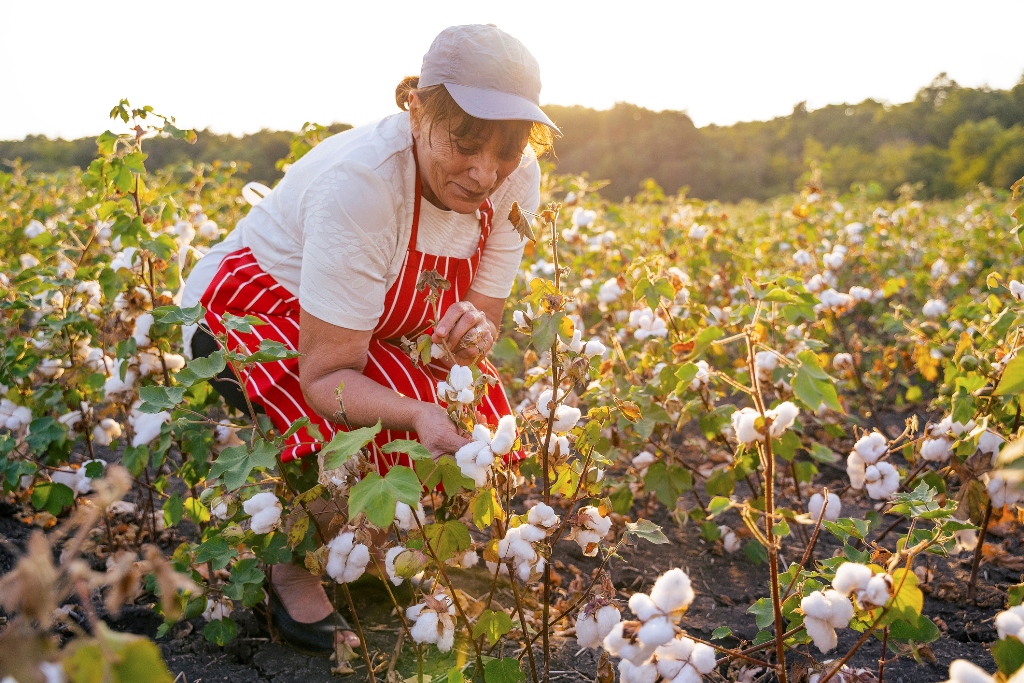
Nearly one in five people who have a job in Alabama can thank the state’s strong agricultural industry for their job. According to the National Agriculture Statistics Service (NASS), agriculture contributes $70.4 billion a year to the state.
This bounty can be attributed to Alabama’s favorable climate and fertile soil. Winters are mild, and summers are hot and humid, with temperatures averaging 80 degrees. Note, however, that temperatures tend to be higher in the southern part of the state near the Gulf Coast, represented by cities like Mobile. Alabama also receives copious amounts of rainfall, more than twice the national average. The “Black Belt” region of central and western Alabama was originally named in the 1820s for the area’s dark topsoil, which was conducive to growing cotton.
Want to know more about the Yellowhammer State’s gargantuan industry? Here are some Alabama agriculture facts to keep in mind.
- Single-crop farming is the industry’s backbone
- Organic farms and hemp are gaining a foothold
- More than a third of Alabama’s farms are run by women
- Individuals or families operate 91% of farms in Alabama
- Poultry is the primary driver for the livestock segment
- In 2017, livestock and poultry accounted for $4.768 billion in state revenues.
- Poultry and eggs took the lion’s share of sales at $4.15 billion.
- Crop production generated $1.21 billion.
Cotton, corn, hay, peanuts, and soybeans are Alabama’s top agricultural cash crops, found in most of the 40,592 farms that occupy 28% of the state’s land area. These crops each contributed hundreds of millions of dollars to the state’s coffers in 2018 alone.
According to state survey data collected by the National Agricultural Statistics Service in 2018, the value of production for each of the five crops were $307.12 million for cotton, $159.9 million for corn, $226.1 million for hay, $118.42 million for peanuts, and $123.37 million for soybeans. A few other crops that generated modest production values were wheat and cucumbers.
Despite the prevalence of single-crop farming, Alabama has seen a rise in organic farms in recent years due to changing consumer habits.
Even though Alabama and other Southern states lag behind their Northern neighbors in the number of certified organic farms, the region is actively chipping away at that statistic. The number of organic farms in Alabama, for example, jumped more than 200% in the last five years (2011-2016). Two other states, South Carolina and Missouri, experienced the same increase in the same period.
Hemp is also a potential key Alabaman crop. The state launched a pilot program in January 2019 allowing growers to produce industrial hemp. The pilot program was a direct result of the 2018 Farm Bill, which reclassified hemp from a controlled substance to an agricultural commodity.
According to the 2017 Census of Agriculture, which has the most recent data on US agriculture, 34% of Alabama farms are owned by women. Raw numbers from the census put the number of farms at 22,201.
That’s a pronounced increase of 13% from 2012, when only 21% of Alabama farms were owned by women. But there is yet another point of pride for the state: Alabama: the percentage of ownership among women is 7 points higher than the national average of 27%
The 2017 agriculture census also notes that 91% of farms in Alabama are run by individuals or families. What’s more impressive about this statistic is that it hasn’t changed in five years since 2012. This means that megacorporations have kept Alabama farmlands in the hands of their resident operators.
Two other interesting statistics for the state’s demographics should be noted. 56% of farmers in Alabama are between the ages of 34 and 65. And about 30% of all farmers are also new to agriculture, with little to no experience beforehand.
Overall, Alabama ranks number 2 in the US for the number of broiler chicken sold, quail inventory, and the value of catfish sold. In fact, the state’s livestock production eclipses its crop production by a wide margin. Livestock makes up 80% of Alabama’s agriculture sales in the US, with the remaining 20% allotted to crops.
Here are more interesting statistics:
Have you ever considered owning a farm in Alabama? As experts in farmland and acreage in West Alabama, we are the real estate team to show you your best options. Contact us, the Bill Mackey Real Estate team, at 334.289.8470 or send an email to bill(at)billmackey(dotted)com. For more about living in Alabama and updates about the local real estate market, check out our blog.
